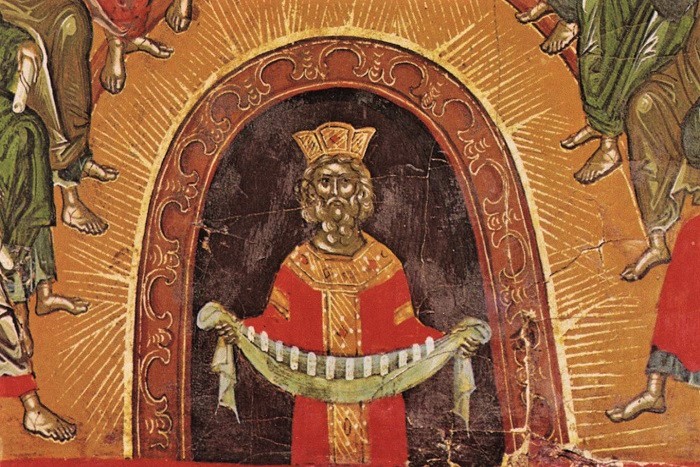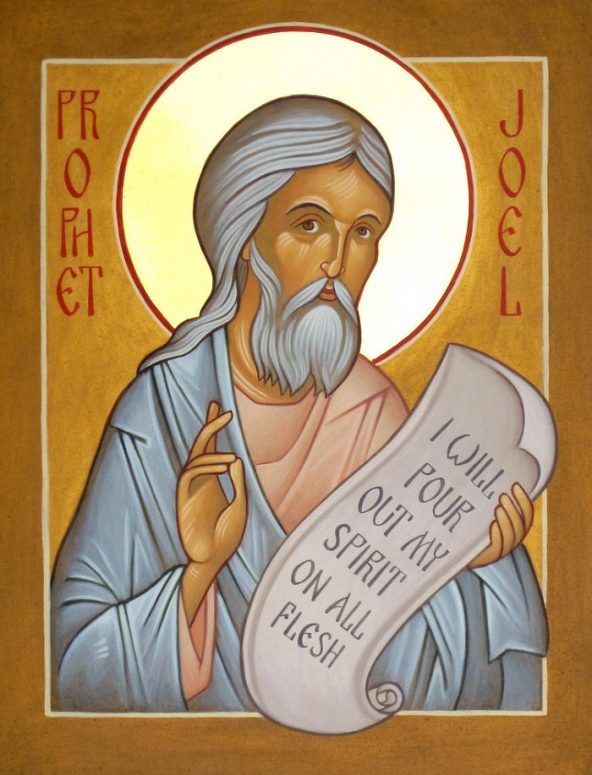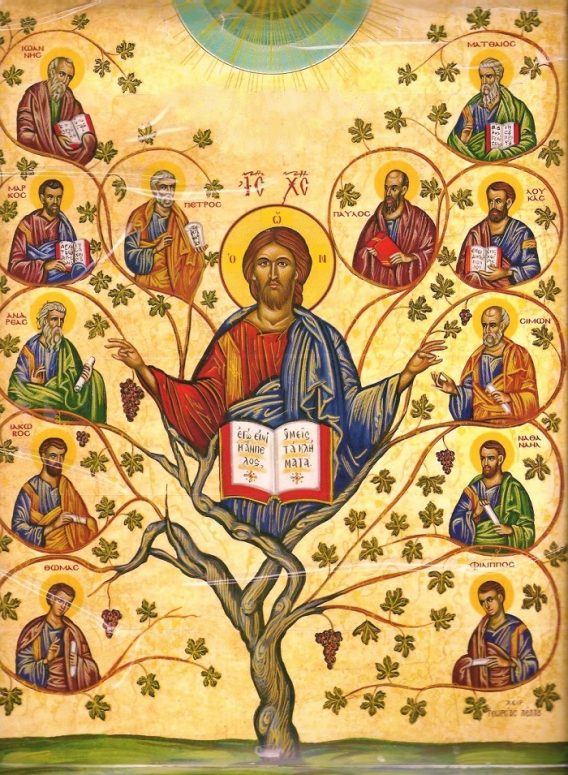
The Church has entered the new liturgical season, the season of Pentecost. This holiday crowns our Savior’s plan of making all human race be like God through sanctification by the Holy Spirit. Pentecost is so important and unique that it starts the count of all subsequent weeks of the liturgical year, thereby reminding us of this crucial event every week. There is an icon of the Descent of the Holy Spirit onto the Apostle on analogions in all Orthodox Churches now. When we kiss it, it is hard not to notice a strange elder’s figure painted at the bottom of the icon. Who is he? Why is that old man painted on the icons of Pentecost and what can we learn from it?
Iconography of Pentecost began to develop in the 6th century. We find icons of the feast on the title pages of the Gospel and the Psalter, in ancient manuscripts, mosaics, and frescoes. Originally, the bottom of the image depicted crowds of people of various ethnic backgrounds. The narrative in the Book of Acts explains it perfectly. Countless Jews from all parts of the world would gather in Jerusalem for the ancient Jewish holiday of Pentecost. There are icons where crowds on dark background are represented by two or three figures.
Byzantine iconography had various ways to portray multitudes of people. Some icons replaced crowds with the figures of the emperor and a black man, representing the Christian world and the savages. Later, icon painters came up with another way to depict the peoples of the world: they painted a king with a cloth and twelve scrolls. There was an inscription “Кόσμος”, which means ‘the Universe’. In spite of the inscription, which isn’t present on every icon, the image and symbolism of the king remains unclear to many Christians.
There is an opinion that the elder on the icon originally meant Prophet Joel, who was later replaced by a king. This position is confirmed by the Book of Acts where Peter, in the sermon he preached immediately after the Descent of the Holy Spirit, mentioned Prophet Joel, saying that it was his prophecy that was fulfilled on that day, I will pour out my spirit upon all flesh; and your sons and your daughters shall prophesy (Joel 2: 28). Although the elder is sometimes inscribed as Joel, it doesn’t look natural in most cases because Orthodox iconography specifies different garments of prophets and kings. Apparently, it is a king, not a prophet, who is portrayed at the bottom of the icons of Pentecost.

According to another version, the icon of Pentecost combines two themes at the same time: that of the election of Apostle Matthias and that of the Descent of the Spirit. Hence, there is an attempt to associate the elder from the icon to King David. King David prophesied in his psalms about the Ascension of the Lord (God is gone up with a shout, the Lord with the sound of a trumpet. Ps. 47:5, etc.) After the Ascension, the apostles gathered in a room, and Apostle Peter suggested replacing Judas Iscariot. He again referred to King David and pointed out that it was David who predicted the betrayal of Judas, For it is written in the book of Psalms, Let his habitation be desolate, and let no man dwell therein: and his bishoprick let another take. (Acts 1: 20). That is the reason why some scholars claim that the elder on the icon is King David, whose twelve scrolls are twelve lots of Apostolic ministry because it was King David who had predicted both the betrayal of Judas and the Ascension of the Lord, after which the Holy Spirit descended onto the apostles. David is separated from the apostles and depicted on a dark background because he belongs to the Old Testament. Needless to say, this version looks coherent and promising in some way but unfortunately, it isn’t the case. It is as artificial as the supposition that the elder is Jesus Christ who had promised to stay with the apostles till the end, in which case his old age means his pre-existence and the fact that He is coequal with the Father; the arch-shaped dark background is taken to symbolize that we do not know where He is now; his red robe points at his redeeming people with his most pure Blood; the crown underlines his royal dignity; the cloth symbolizes his purity; while the scrolls are the apostles whom He keeps in his hand.

The genuine explanation of the icon’s symbolism must be based on the principle of continuity of images, the theological message of the icon, and its ancient originals. The elder’s figure did not appear out of the blue: it was meant to be a collective symbol of crowds of nations. The king at the bottom is the human race that is waiting for the apostles to preach their redemptive Good News, and to be anointed by the Holy Spirit. The twelve scrolls represent the teaching of the Twelve Apostles, which is stored piously on a cloth. The darkness around is a symbol of ignorance that shall be overcome thanks to the Spirit. The elder is more than a symbol of the human race. He represents the entire world, the whole Cosmos that needs to be permeated by the uncreated divine energies that emanate from God. For the creature was made subject to vanity, not willingly, but by reason of him who hath subjected the same in hope (Rom. 8: 20). Although the Cosmos is now in darkness, it didn’t lose its crown because it was only the Man who fell, and not the Cosmos as a whole. We may recognize ourselves in the image of that elder. We have grown old, longing for the Living God with the rest of the world. The alternative Divine reality has broken into this world. Each of us can follow that elder and stretch out our hands to receive the Good News and the Sacrifice of Jesus Christ.
The icon of the Pentecost immerses us in the cosmic experience of that glorious event and declares the universal calling of the Church to make us, and the whole world with us, holy, and bring this new, redeemed, world to the Father. Each one of us is a small particle of the new reality of the Church, called up to be God’s fellow worker and to make his or her contribution to the cause of transforming the life around us.




Good Evening! Peace…..I am wondering if the old man wearing the Crown in the Icon of Pentecost is Jesus holding His Shroud? Please let me know if this could be correct/possible…Tks! God bless…..
Greetings! It is not Jesus. It is the cosmos – whole world, which must accept the Gospel. Also this old man is a personification of all nations.